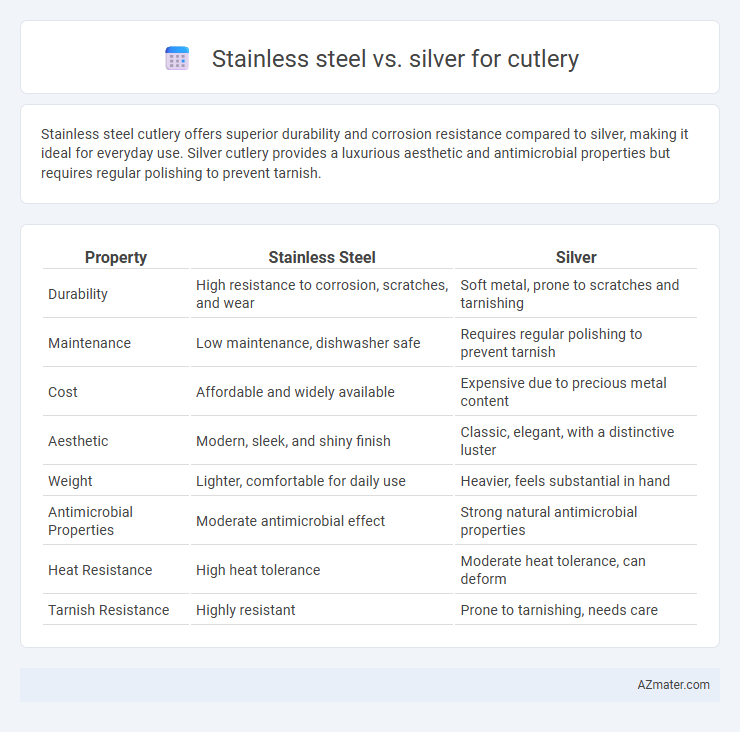Stainless steel cutlery offers superior durability and corrosion resistance compared to silver, making it ideal for everyday use. Silver cutlery provides a luxurious aesthetic and antimicrobial properties but requires regular polishing to prevent tarnish.
Table of Comparison
| Property | Stainless Steel | Silver |
|---|---|---|
| Durability | High resistance to corrosion, scratches, and wear | Soft metal, prone to scratches and tarnishing |
| Maintenance | Low maintenance, dishwasher safe | Requires regular polishing to prevent tarnish |
| Cost | Affordable and widely available | Expensive due to precious metal content |
| Aesthetic | Modern, sleek, and shiny finish | Classic, elegant, with a distinctive luster |
| Weight | Lighter, comfortable for daily use | Heavier, feels substantial in hand |
| Antimicrobial Properties | Moderate antimicrobial effect | Strong natural antimicrobial properties |
| Heat Resistance | High heat tolerance | Moderate heat tolerance, can deform |
| Tarnish Resistance | Highly resistant | Prone to tarnishing, needs care |
Introduction: Choosing the Best Material for Cutlery
Stainless steel and silver are two popular materials used for cutlery, each offering distinct advantages for kitchen and dining use. Stainless steel is celebrated for its durability, resistance to corrosion, and affordability, making it ideal for everyday use. Silver cutlery, known for its elegant appearance and antimicrobial properties, is often favored for formal settings but requires more maintenance to prevent tarnishing.
Composition and Properties: Stainless Steel vs Silver
Stainless steel cutlery primarily consists of iron alloyed with chromium (usually 10-20%) and often nickel, providing corrosion resistance, high durability, and strength. Silver cutlery is made from 92.5% pure silver (sterling silver) combined with copper or other metals to increase hardness, offering excellent antimicrobial properties and a lustrous finish but lower resistance to scratches and bending. The differing compositions result in stainless steel's superior resistance to rust and everyday wear, while silver excels in aesthetics and antimicrobial qualities.
Durability and Longevity Comparison
Stainless steel cutlery is highly durable due to its resistance to corrosion, rust, and staining, making it ideal for everyday use and long-term longevity. Silver cutlery, while offering a luxurious aesthetic and natural antimicrobial properties, requires regular polishing and careful maintenance to prevent tarnishing and degradation over time. In terms of lifespan, stainless steel generally outperforms silver by maintaining its appearance and structural integrity with minimal upkeep.
Maintenance: Cleaning and Care Requirements
Stainless steel cutlery requires minimal maintenance, as it is resistant to rust, stains, and corrosion, making it dishwasher-safe and easy to clean with mild detergents. Silver cutlery demands more careful handling to prevent tarnishing, often needing regular polishing with silver-specific cleaners and gentle hand washing to maintain its shine. Proper storage in anti-tarnish cloth or cases significantly extends the lifespan and appearance of silver cutlery compared to stainless steel.
Aesthetics: Appearance and Style Differences
Stainless steel cutlery offers a modern, sleek appearance with a polished or matte finish that complements contemporary table settings. Silver cutlery provides a classic, luxurious look, often featuring intricate designs and a warm luster that enhances formal dining experiences. While stainless steel is valued for its consistent shine and durability, silver's timeless elegance and patina deepen its aesthetic appeal over time.
Health and Safety Considerations
Stainless steel cutlery offers superior resistance to corrosion, bacteria, and staining, making it a hygienic choice for daily use. Silver cutlery, while antimicrobial due to its ion-releasing properties, requires regular polishing to prevent tarnish and potential contamination. Both materials are safe for food contact, but stainless steel's durability and low maintenance contribute to better long-term health and safety.
Cost Analysis: Initial Investment and Long-term Value
Stainless steel cutlery typically requires a lower initial investment compared to silver, making it a cost-effective choice for everyday use. Silver cutlery, despite its higher upfront cost, offers long-term value through durability and potential metal value appreciation. Maintenance expenses for silver, including polishing and tarnish prevention, can increase overall costs compared to the minimal upkeep needed for stainless steel.
Environmental Impact and Sustainability
Stainless steel cutlery boasts a lower environmental impact due to its durability, recyclability, and resistance to corrosion, which extends its lifespan and reduces waste. Silver cutlery, while recyclable, requires intensive mining and refining processes that generate higher energy consumption and ecological degradation. Choosing stainless steel supports sustainability by minimizing resource extraction and promoting longer product use cycles.
Popular Uses: Everyday vs Special Occasions
Stainless steel cutlery is favored for everyday use due to its durability, resistance to corrosion, and affordability, making it ideal for frequent washing and casual dining. Silver cutlery, prized for its elegance and traditional appeal, is commonly reserved for special occasions and formal dining settings, enhancing the table's aesthetic with its lustrous finish. While stainless steel offers practicality and low maintenance, silver cutlery is valued for its cultural significance and timeless beauty.
Conclusion: Which Cutlery Material Is Right for You?
Stainless steel cutlery offers durability, resistance to rust, and low maintenance, making it ideal for everyday use and families. Silver cutlery provides a classic, elegant appearance and antimicrobial properties but requires regular polishing and careful handling. Choosing between stainless steel and silver depends on your lifestyle, budget, and preference for convenience versus timeless aesthetic.

Infographic: Stainless steel vs Silver for Cutlery
 azmater.com
azmater.com